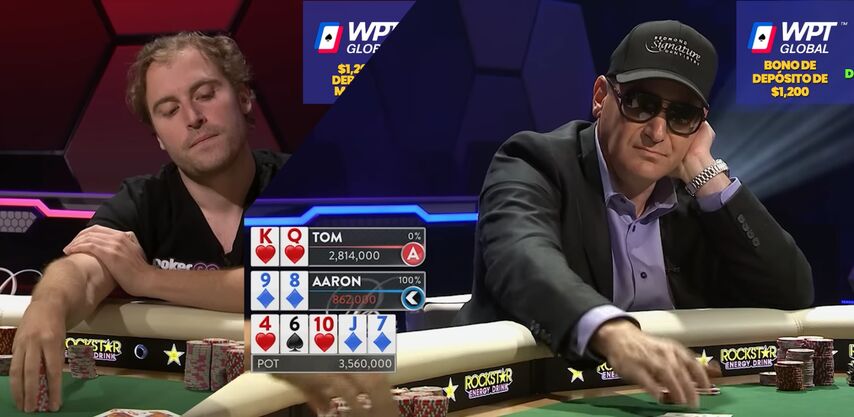What is barrel in poker and what do players mean by “triple-barreling” and “three-barreling”?
A barrel in poker is when a player bets on the flop, then the turn, and also on the river. You can refer to this as “barreling” or “triple barreling”, but if you only bet twice, it’s called a “double barrel”.
Poker players almost always use these terms for bluffing. Barreling across multiple streets (betting rounds) creates large pots and a lot of pressure on your opponents, even if they have a strong hand.

A triple barrel bluff is essential for opponents who need a little extra convincing. You need to be careful about your timing though; it can get very expensive if you triple-barrel at the wrong moment.
This article will cover the basic strategy for the classic triple barrel bluff.
The guide will apply to cash game and tournament (MTT) poker, including freerolls.
When and How to Fire Three Barrels as a Bluff
You’ve decided to bluff, but your opponent fearlessly calls your bet on the flop.
Sometimes, you’re going to need to bet on the flop, turn, and river to get your opponent to fold. Knowing when to triple-barrel bluff and when to stop betting is important.
Here are some things you must think about:
Your Perceived Range
It’s very important to consider your perceived range, meaning the range your opponent can reasonably think you have. Preflop action tells a story about your possible hand. Think about the hands you want to represent and make sure your actions match up.
Imagine you are playing heads-up and you are in-position on the button. Your opponent made a small raise already, but you decide to make a 3-bet.
Your perceived range includes the hands you might 3-bet with. This includes premium hands like AA, KK, QQ, JJ, and so on, plus several suited combinations of Ace-x (Ace-5, Ace-4, etc).

Your range needs to match your actions. If you triple-barrel bluff, you should choose a board texture that “hits your range”, meaning your range often connects with the community cards.
Your Opponents Range
You should always consider your opponent’s range when you triple-barrel bluff. Some opponents are very tight players, while others can be loose. Would you rather try to bluff the opponent who plays premium hands or the one who loosely calls almost any bet?
Always consider your opponent's range, because it will be much more difficult to triple-barrel bluff an opponent with a strong range. A loose player may be happy to call your flop bet, and perhaps your double-barrel turn bet, but the third barrel will be a tough decision for them.
Triple barreling against tight opponents who only play a few hands an hour might not be clever. Choose your customer carefully and take note of their habits to correctly apply the triple barrel bluff maneuver.

If possible, you should always check a player's VPIP using a HUD. This stat tells you how often they voluntarily play hands.
If you’re using a heads-up display (HUD), you’ll be able to see which players are tight and loose at your table. Any serious poker player you come across at the poker table is probably already using a HUD since they are allowed on most poker sites. They give real-time data about opponents and can shed light on their betting habits (and weaknesses too).
Community Cards [Did That Card Help My Opponent?]
Certain cards will improve or decrease the effectiveness of your triple or double-barrel bluff. This applies to the flop, turn, and river cards. Do they favor your opponent’s range, or yours?
If you are representing a strong hand combination, you’d better make sure that the board texture is telling the same story. If your opponent thinks that your range does not match the board texture, they might be able to re-bluff you or call each of your barrels.
Triple barrel bluffs can go seriously wrong if the bluffer is blindly betting. If your opponent completes their draw, you might end up losing a lot of chips.
This ties back to understanding your opponent’s range. Think about the draws that were completed on the turn or river, like flush and straight draws.

Brick Cards: The meaning of a “brick” in poker is a turn or river card that is very unlikely to change any player’s hand strength. A brick doesn’t complete any draws and is a safe card to continue barreling with. The opposite of a brick is an “action card”.
Practice Your Triple Barrel Bluffs Risk-Free
If you need a place to practice barreling while considering ranges and board textures, why not try some freeroll tournaments? There is no entry cost, but you can still win real-money prizes or tickets to larger real-money tournaments.
At the beginning of these freeroll tournaments, things might be a little wild. It doesn’t cost anything to enter, so some players will risk it all in the early stages. After the blinds increase, this will change.
You could also try low-stakes cash games on a soft poker site like 888poker or PokerStars. In a $0.01/$0.02 game of Hold ‘em or Omaha, the maximum buy-in is $2. If you go up to $0.05/$0.10, the maximum buy-in is $10. That’s not a large investment, but it will allow you to play for quite a long time if you are careful.
Most poker rooms have bonuses that you can get with small deposits. For some rooms, it’s $10, but $20 is the most common amount.
Here are a few rooms with their bonuses:
- 888poker = Up to $88 in rewards just for signing up
- America’s Cardroom = 100% matched deposit up to $2000 (minimum
- PokerStars = $30 FreePlay Bonus with a $10 deposit



























